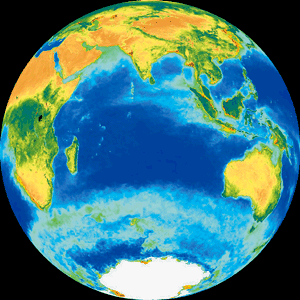Latest Findings from Rosetta
Monday, December 22nd, 2014December 22, 2014
Earth’s water may not have come from melting comets, according to a paper published in December 2014 by scientists working on the European Space Agency’s Rosetta mission. The Rosetta spacecraft, launched in 2004, went into orbit around P67/Comet Churyumov-Gerasimenko in 2014, landing a small probe on the comet’s nucleus (core) in November.
Most researchers think that the hot, turbulent formation of Earth would have left the early planet dry. Scientist have thus struggled to determine how Earth got its oceans. Most researchers agree that the water was delivered by smaller bodies crashing into the young planet. Such bodies may have been comets or asteroids.

Scientists are still unsure of the source of the water in Earth’s oceans, which cover most of the planet’s surface. This satellite view shows the Indian Ocean, partly bordered by Africa, Asia, and Australia, and below it the Southern Ocean surrounding Antarctica. (NASA/Goddard Space Flight Center and ORBIMAGE/SeaWiFS Project)
Scientists working with an instrument called the Rosetta Orbiter Spectrometer for Ion and Neutral Analysis (ROSINA) analyzed water from Comet Churyumov-Gerasimenko to see if it was similar to water found on Earth. Water consists of the elements hydrogen and oxygen. Some of the hydrogen, however, is in a heavier isotope (form) called deuterium. By comparing the ratio of deuterium to ordinary hydrogen in different samples, scientist can tell if the water in each sample is from the same place.
The researchers discovered that the water analyzed by the ROSINA instrument has a higher ratio of deuterium to hydrogen than does Earth’s water. The finding casts doubt that the water on Earth came from comets like Churyumov-Gerasimenko. However, Earth’s water may have come from bombardment by asteroids or from a different population of comets.


